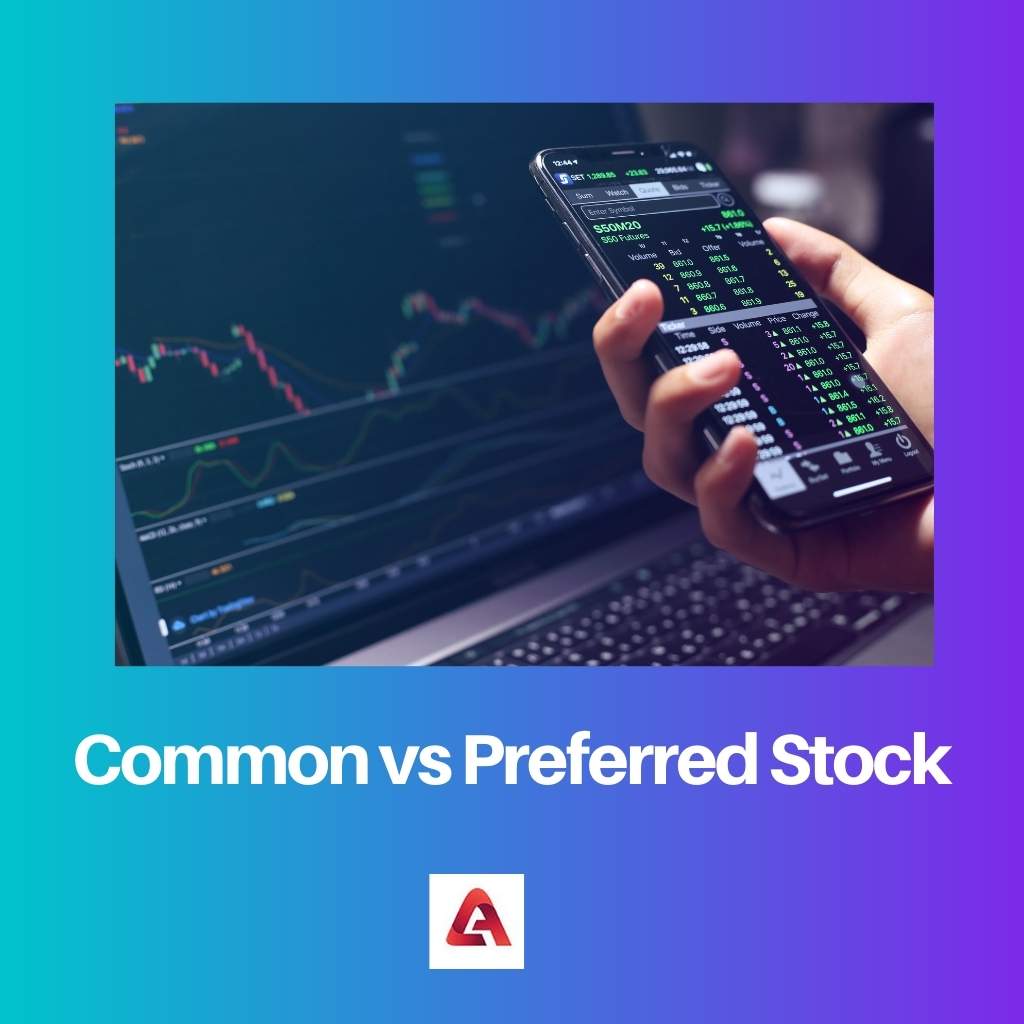Shareholders in a corporation may own either ordinary stock or preferred stock, which together make up the company’s securities and assets.
They are both components of a business’s ownership structure, as well as instruments that investors demand from a company in return for their financial contributions.
Key Takeaways
- Common stockholders have voting rights, while preferred stockholders do not.
- Preferred stock has priority over common stock for dividend payments and company asset distribution.
- Dividends for preferred stock are fixed, whereas common stock dividends can vary based on company performance.
Common vs Preferred Stock
Preferred Stock gives no voting rights to shareholders, while common stock does. Preferred stockholders are paid before common stockholders receive dividends. Lastly, Preferred stockholders have a higher dividend yield than what common stockholders or bondholders receive.

Common stock offers investors a piece of a company’s ownership. Many businesses only issue common stock, and common stock sells for a lot more on stock markets than preferred stock.
The Common stockholders have the ability to vote on the board of directors and approve key business decisions such as mergers and acquisitions (although some companies have a non-voting class of common shares).
Preferred stock is more similar to a bond than an ordinary stock.
Preferred stock dividends are considerably larger than common stock dividends and are set at a particular pace, while common stock payouts may fluctuate or even be eliminated.
The Preferred stock also has a fixed redemption price that a business will pay to redeem at some point in the future.
This redemption value, like the maturity value of a bond, sets a limit on how much-preferred stock investors are prepared to pay.
Comparison Table
| Parameters of Comparison | Common Stock | Preferred Stock |
|---|---|---|
| Held to Maturity Value | It varies. | It is full. |
| Voting Rights | Contains the right to vote. | Does not contain rights to vote. |
| Call Feature | Does not contain a call feature. | It has a call feature. |
| Payment of dividends | Dividends aren’t set in stone or required. | Dividends are required and are, for the most part, set. It should be paid before dividends are given to common stockholders. |
| Liquidation of Company | In the event of the company’s collapse, they are paid last in line. | Given preference more than common stocks. |
What is Common Stock?
The most common kind of stock is common stock, which reflects a company’s shares of ownership. When people talk about stocks, they refer to common stock.
In fact, this is how a lot of stock is distributed. Ordinary shares are a claim on profits (dividends) and also allow you to vote.
Investors elect board members who oversee management’s important decisions with one vote per share.
Compared with preferred shareholders, shareholders have a greater influence on business policies and management issues.
Bonds and preferred stocks tend to perform worse than common stocks. It’s also the kind of stock with the best long-term growth prospects.
If a company performs well, the value of its common stock may increase. Keep in mind, however, that if the company performs poorly, the stock’s value will fall as well.
When it comes to dividends, a company’s board of directors decides whether or not to pay them to ordinary shareholders.
When a company fails to pay a dividend, the ordinary shareholder loses out in favour of preferred stockholders, suggesting that the latter has a greater priority.

What is Preferred Stock?
Preferred shareholders, as a result, have no voice in the company’s future when it comes to electing a board of directors or voting on corporate policies.
Preferred stock, like bonds, provides investors with a guaranteed income for the rest of their life. Divide the dividend amount by the stock’s price to get the dividend yield of the preferred stock.
The par value is used to determine whether or not a preferred stock should be issued. It’s calculated as a percentage of the current market price after it begins trading.
A common stock, on the other hand, pays a fluctuating dividend that is announced by the board of directors and is never guaranteed. In fact, many companies do not pay dividends to ordinary shareholders.
The face value of preferred stocks (such as bonds) is affected by interest rates. Preferred shares depreciate as interest rates rise and vice versa.
On the other hand, the supply and demand of market participants will affect the value of the common stock.

Main Differences Between Common and Preferred Stock
- The Value, if Held to Maturity, varies in the case of common stocks and is full in the case of preferred stocks.
- Common stocks contain the right to vote, whereas Preferred stocks do not contain the right to vote
- Common Stock has a call feature, whereas preferred stocks do not contain a call feature.
- Dividends aren’t set in fixed or required in the case of common stocks, whereas in preferred stocks, dividends are required and are, for the most part, set. It should be paid before dividends are given to common stockholders.
- In the event of the company’s collapse, common stocks are paid last in line. Preferred stocks are given preference more than common stocks.

- https://www.sciencedirect.com/science/article/pii/0165410186900030
- https://heinonline.org/hol-cgi-bin/get_pdf.cgi?handle=hein.journals/pnlr161§ion=49

The detailed comparison between common and preferred stock is immensely helpful in understanding their distinct characteristics and implications for investors.
I completely agree, the article is a valuable resource for decoding the complexities of stock ownership.
The article’s approach to dissecting common and preferred stock is highly intellectual and enlightening. It provides a wealth of knowledge on the subject.
The explanations regarding common stock and preferred stock are detailed and comprehensive. This article is a great resource for those seeking to expand their understanding of stock ownership.
Absolutely, the article delves deep into the nuances of common and preferred stock, making it an enriching read for anyone interested in the subject.
The content that describes the differences in voting rights and dividend payments between common and preferred stock is well-articulated and serves as a valuable educational tool.
Fully agree, the article presents an intellectual analysis of common and preferred stock, making it highly informative for readers.
The article does an excellent job of clarifying the difference between common and preferred stock. It’s informative and easy to understand.
Absolutely agree, the information provided is extremely clear and helpful.
The article effectively highlights how common stock offers ownership and voting rights within a company, while preferred stock holds priority for dividends. Very informative indeed.
I found the comparison between common and preferred stock particularly illuminating. It provides a clear distinction between the two types of stock.
The section detailing the characteristics of common stock and preferred stock is very thorough and insightful. It’s beneficial for investors to understand these distinctions.
I couldn’t agree more. The content provides valuable knowledge for individuals interested in the stock market.
The comparison table provided is very useful in understanding the key differences between common and preferred stock. It’s a great visual aid.
I appreciate how the article outlines the voting rights and dividend payment differences between common and preferred stock in a clear manner.
Indeed, a well-structured and informative table for quick reference.
The comprehensive details on the main differences between common and preferred stock are presented in a very engaging manner. This article is a valuable resource for understanding stock ownership.
The clarity in explaining the differences between common and preferred stock is commendable. It truly enhances the reader’s understanding of these concepts.
The valuable insights provided in this article are beneficial for anyone seeking to delve into the intricacies of stock ownership.
The article delivers comprehensive information on both common and preferred stock, making it an essential read for individuals interested in enhancing their knowledge of the stock market.
The content offers a profound understanding of common and preferred stock. It is an exceptional educational piece for anyone looking to broaden their expertise in the stock market.
The in-depth explanations on common and preferred stock in this article are truly enlightening.
The analytical depth of the article’s content sets it apart as an invaluable resource for individuals aiming to grasp the nuances of stock ownership.